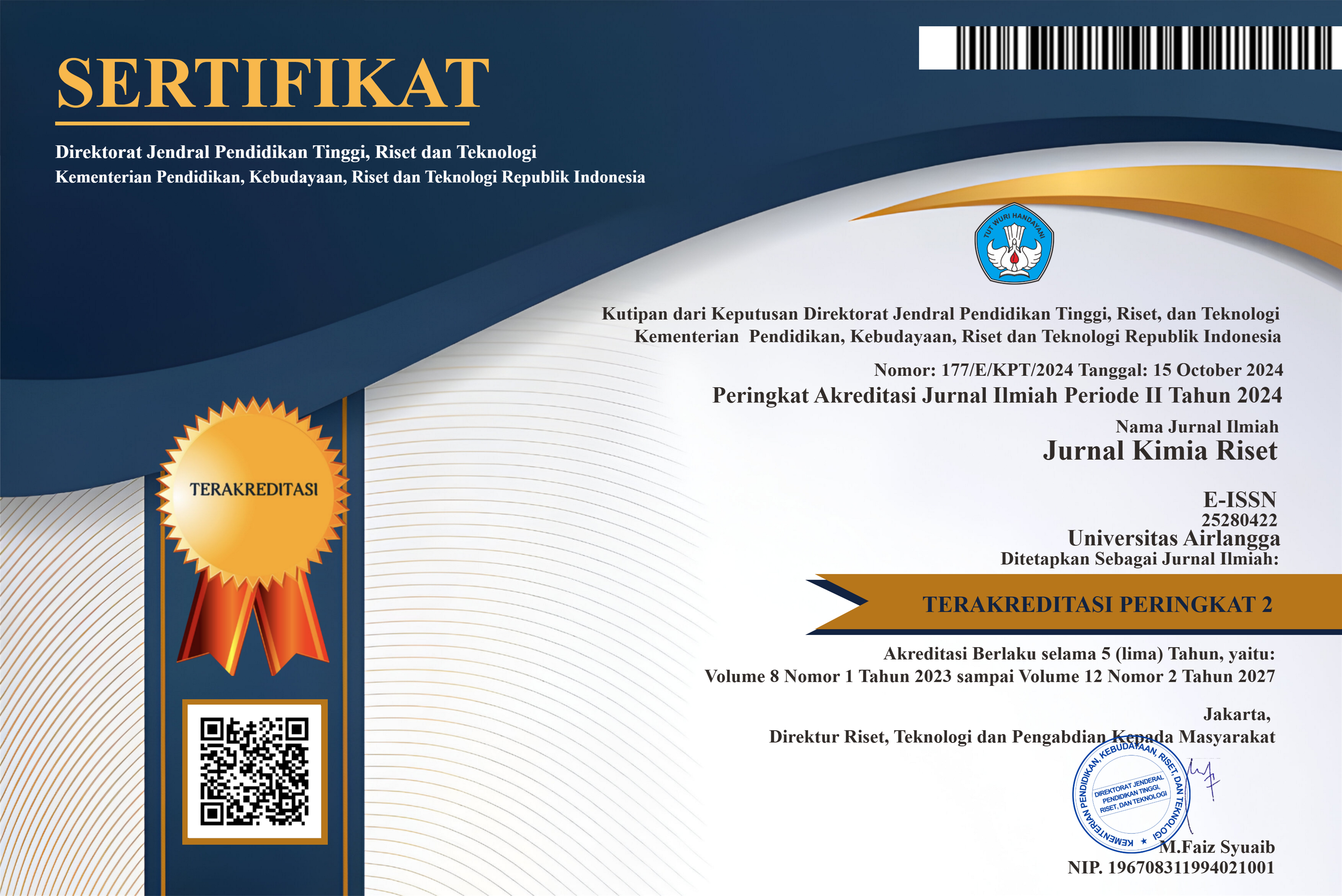EFFECT OF MICROWAVE IRRADIATION TIME TO DEACETYLATION PROCESS OF CHITIN FROM SHRIMP SHELLS
Downloads
Microwaves have been used in various organic synthesis applications. The use of microwaves provides many advantages, including relatively short start-up and heating times, energy efficiency and process costs, easy and precise process control, selective heating, better final product quality, and improved dry material quality. Microwaves were used in this study to convert chitin into chitosan and to determine the effect of deacetylation time on the degree of deacetylation of chitosan, which was in accordance with the Indonesian National Standard (SNI 7949:2013). The chitin deacetylation process was carried out by varying the heating time to 5, 7, 11, and 15 minutes with a power of 350 W. Two grams of chitin were mixed with 40 mL of 70% NaOH solution in a beaker. The mixture was put in a microwave at a constant temperature of 70 °C. Chitosan was washed until neutral and then dried in an oven. The degree of deacetylation (DD) was analyzed using Fourier Transform Infrared (FTIR) spectroscopy. The results showed that A deacetylation degree of 79.96% was achieved at a reaction time of 15 min. The water content of chitosan was determined to be 9.15%.
Agustina, S., Swantara, I. M. D. and Suartha, I. N., 2015. Cystin Isolation, Characteristics, and Synthesis of Chitosan from Shrimp Shell. Journal of Chemistry 9 (2). Udayana University, Bali.
Ajavakom, A., Supsvetson, Sulaleewan., Somboot, Aimjit., Sukwattanasinitt, Mongkol., 2012. Products from microwave and ultrasonic wave assisted acid hydrolysis of chitin, Carbohydrate Polymers, 90(1), pp. 73–77.
Arifin, Z., and Effensi, M., 2017. Demineralization of Shrimp Scalp Waste Using Organic Acid Solvents in the Context of Chitosan Manufacturing, National Seminar on Innovation and Technology Applications in Industry 2017, ISSN 2085-4218, D21.1-D21.4.
Dono, A., 2012. Effect of NaOH Concentration and Time on the Process of Deacetylation of Chitin into Ultrasonic-Assisted Chitosan, Final Project, Samarinda State Polytechnic, Samarinda.
Dumais, Y., 2013. The Kinetics of the Deacetylation Reaction of Chitin into Ultrasonically Assisted Chitosan. Final Project, Samarinda State Polytechnic, Samarinda.
Grifoll-romero, L. and Pascual, S., 2018. Chitin Deacetylases: Structures, Specificities, and Biotech Applications, (Figure 1), pp. 1–29.
Langa, F., Cruz, Pilar D E L A., Hoz, Antonio D E L A., Diaz-ortizh, Angel., Ez-barra, Enrique D., 1996. Microwave irradiation : more than just a method for accelerating reactions, pp. 373–386.
Mohan, K., Ramu Ganesan, Abirami., Ezhilarasi, P.N., Kumar, Kiran., Kondamareddy., Karthick Rajan, Durairaj., Sathishkumar, Palanivel., Rajarajeswaran, Jayakumar., Conterno, Lorenza., 2022. Green and eco-friendly approaches for the extraction of chitin and chitosan, 287.
Mojarrad, J.s., Mahboob, N., Valizadeh, H., Ansarin, M., and Bourbour., 2007. Preparation of Glucosamine from Exoskeleton of Shrimp and Predicting Production by Response Surface Metodhology. Journal of Agricultural and Chemistry, 55, 2245.
Sahu, A., Goswami, P. and Bora, U., 2009. Microwave Mediated Rapid Synthesis of Chitosan, Jurnal Mater Sci, 2009: 171–175.
Sakti, L., 2011. Optimization of Chitin Deacetylation Process in The Treatment of Mahakam Delta Shrimp Waste into Chitosan, Final Project, Samarinda State Polytechnic, Samarinda.
Septiwi, S. . D., 2014. Decontamination of Metal Ions with Biosorbents based on Humic Acid, Chitin and Chitosan. Yogyakarta: Gaja Mada Univesity Press.
Srijianto, B., 2003. Chemical Chitin and Chitosan Production Process Technology Development. Proceedings of the Indonesian National Seminar on Chemical Engineering 2003, 1(1): 1-5.
Sumnu, G., 2001. A Review on Microwave Baking of Foods, International Journal of Food Science & Technology, 36 (2): 11.
Zaeni, A., Fuadah, B. and Sudiana, I. N., 2017. Microwave Effect on Chitin Deacetylation Process from Shrimp Shell Waste. Journal of Physics Applications Volume 13 Number 2. Haluoleo University, Faculty of Mathematics and Natural Sciences, Southeast Sulawesi.
Copyright (c) 2023 Jurnal Kimia Riset

This work is licensed under a Creative Commons Attribution-NonCommercial-ShareAlike 4.0 International License.
COPYRIGHT NOTICE
1. By submitting the article to Jurnal Kimia Riset (JKR), the author has agreed to transfer some of the copyrights to the publisher of the research chemistry journal, Universitas Airlangga, indicated in the Copyright Transfer Agreement.
2. Authors still retain significant rights to use and share their own published articles for non-commercial purposes subject to Creative Commons Attribution-NonComercial 4.0 International License
3. All publications (printed/electronic) are open access for educational purposes, research, library, and other non-commercial purposes. Besides the purposes mentioned above, the editorial board is not responsible for copyright violations.















